#this is not tibetan robe
Photo




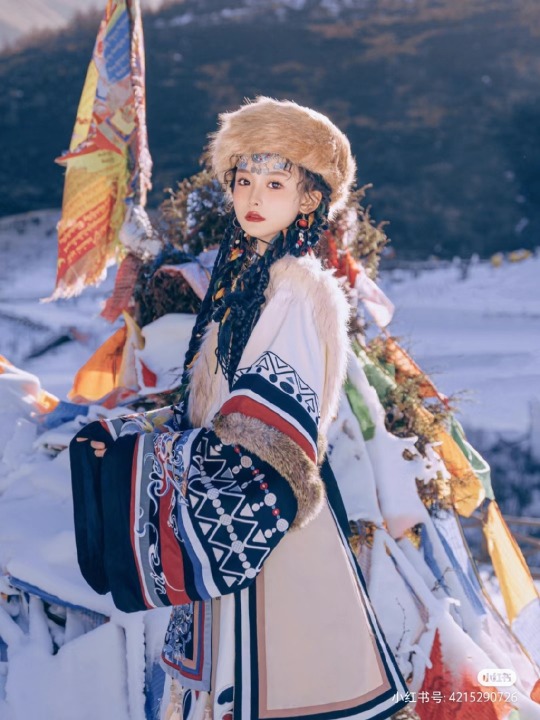

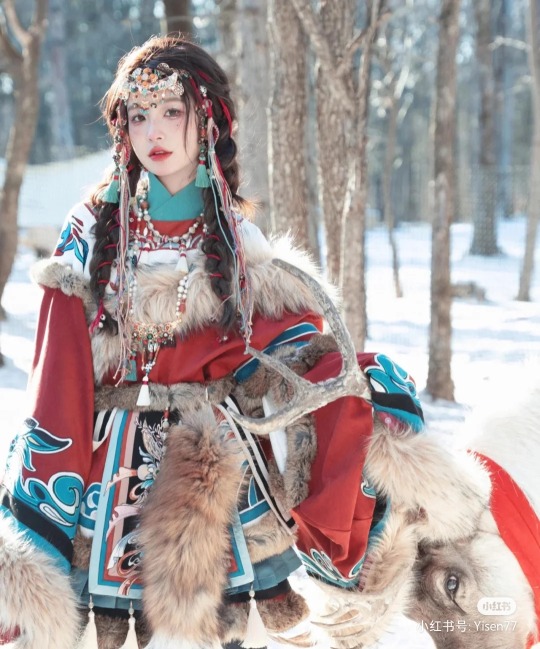
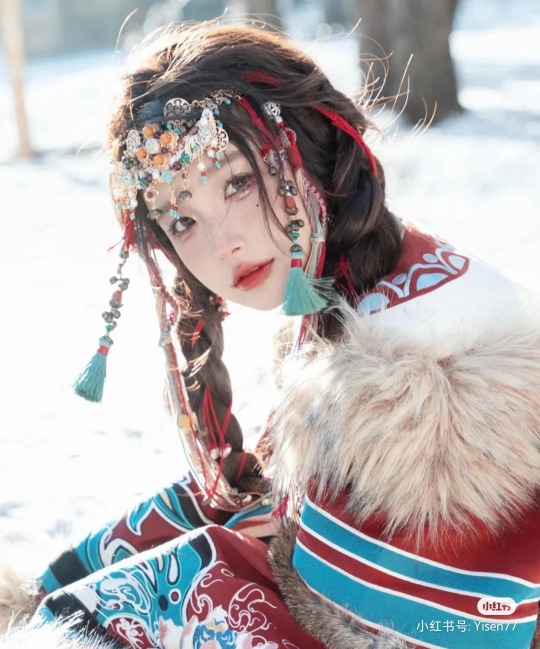


chinese hanfu matched with tibetan fashion on xiaohongshu
#china#fashion#hanfu#tibetan elements#chinese fashion#this is not tibetan robe#hats and accessories are tibetan inspired style#it's more like hanfu+tibetan inspired costume to me#some patterns are hanfu inspired some are tibetan inspired
1K notes
·
View notes
Photo
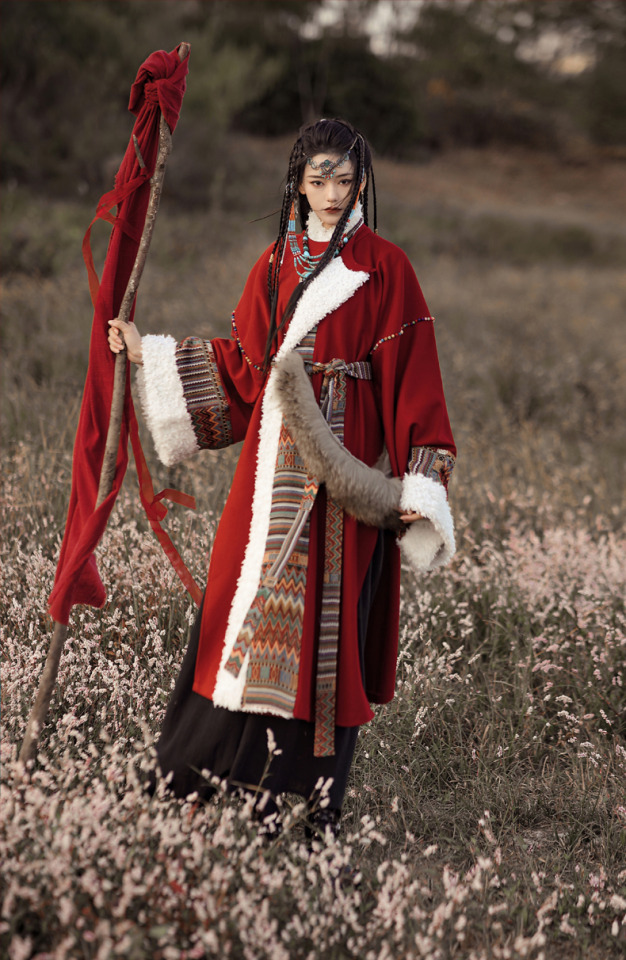
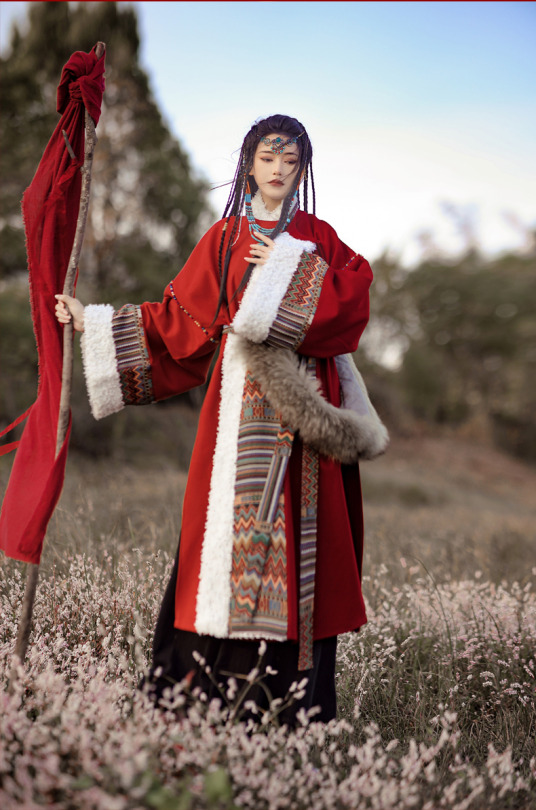
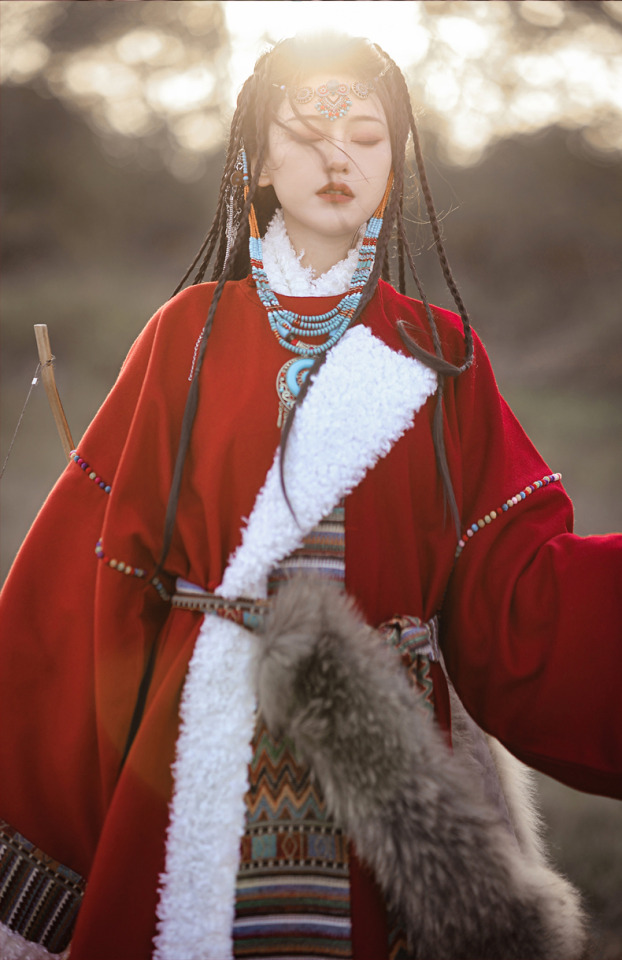
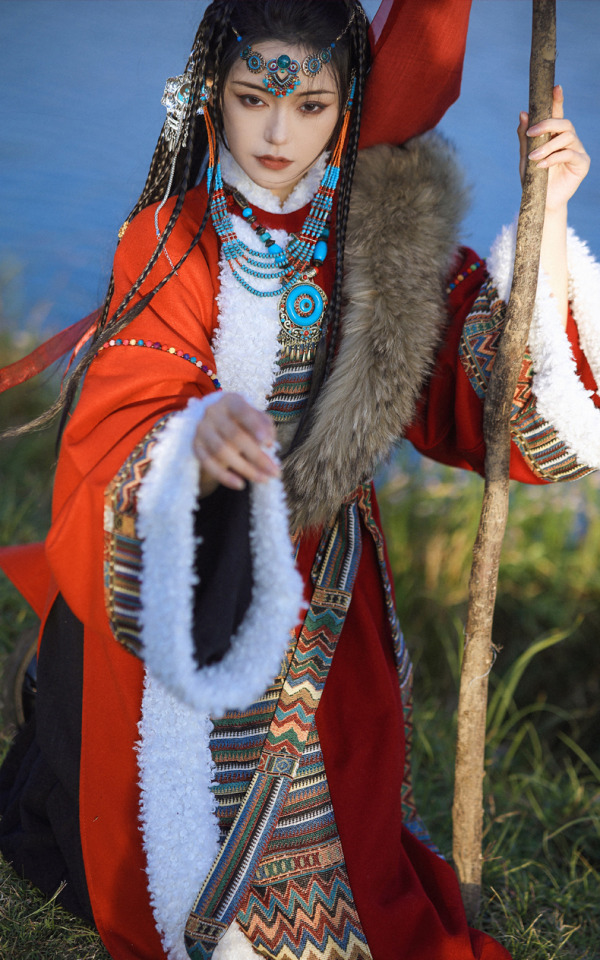
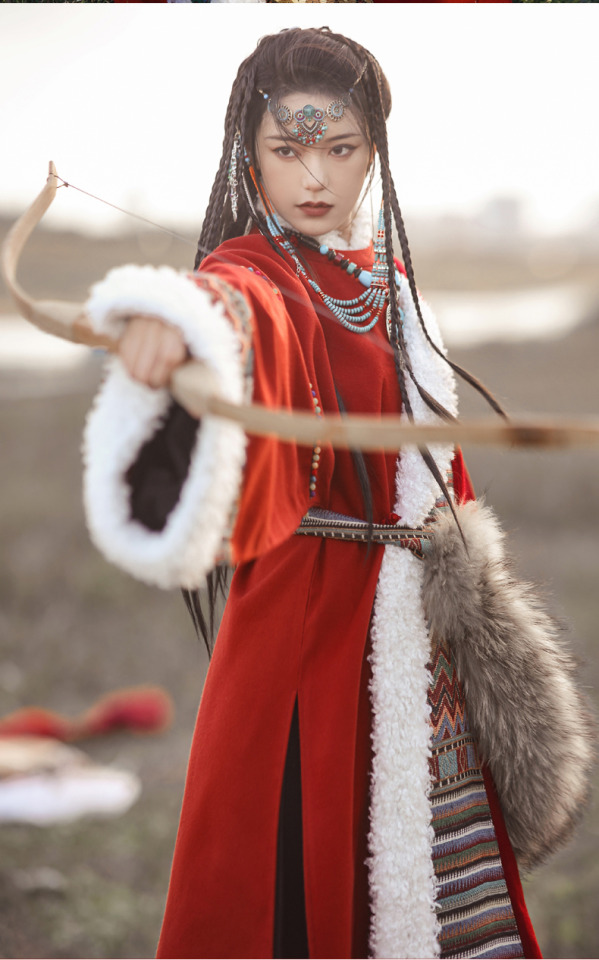
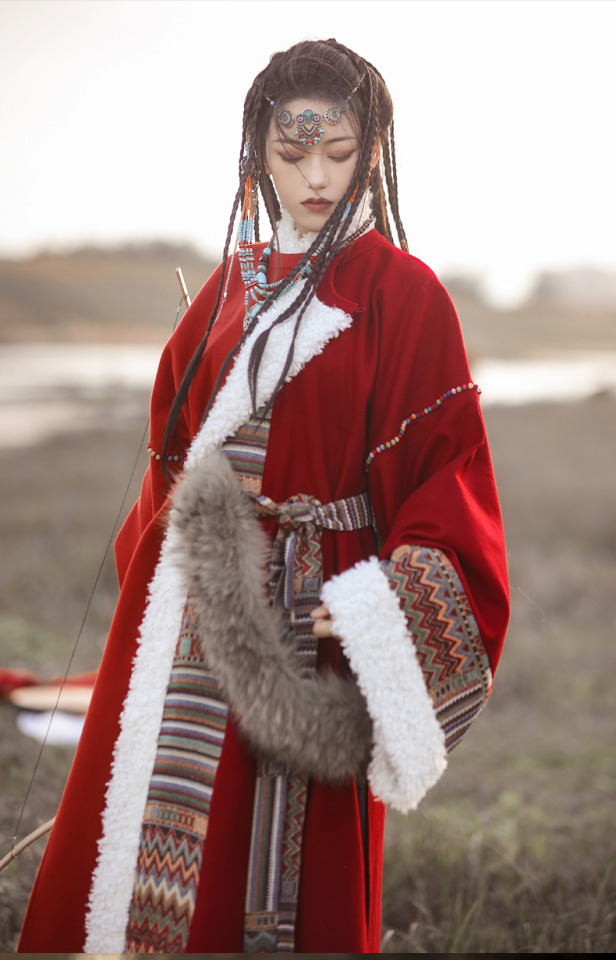
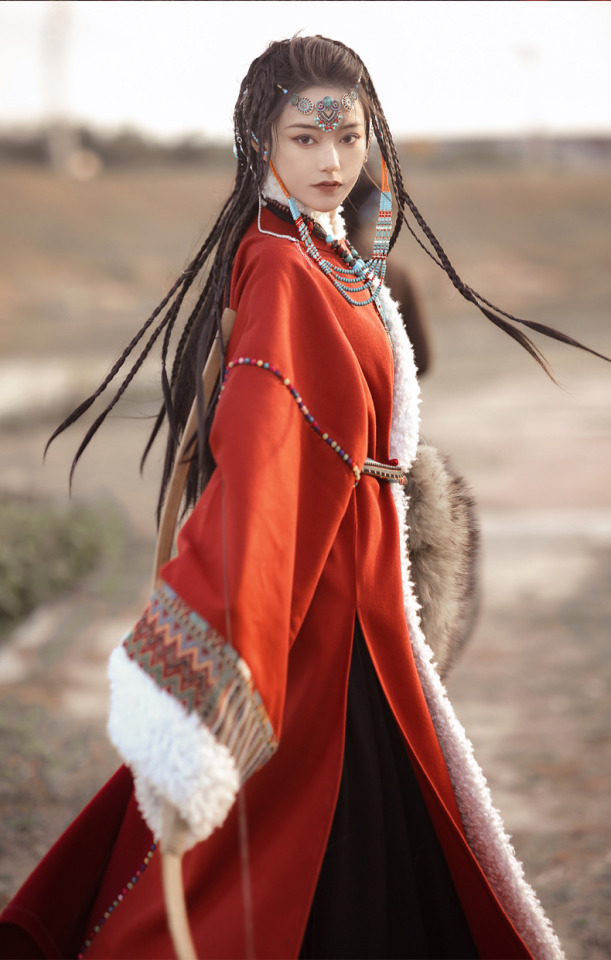

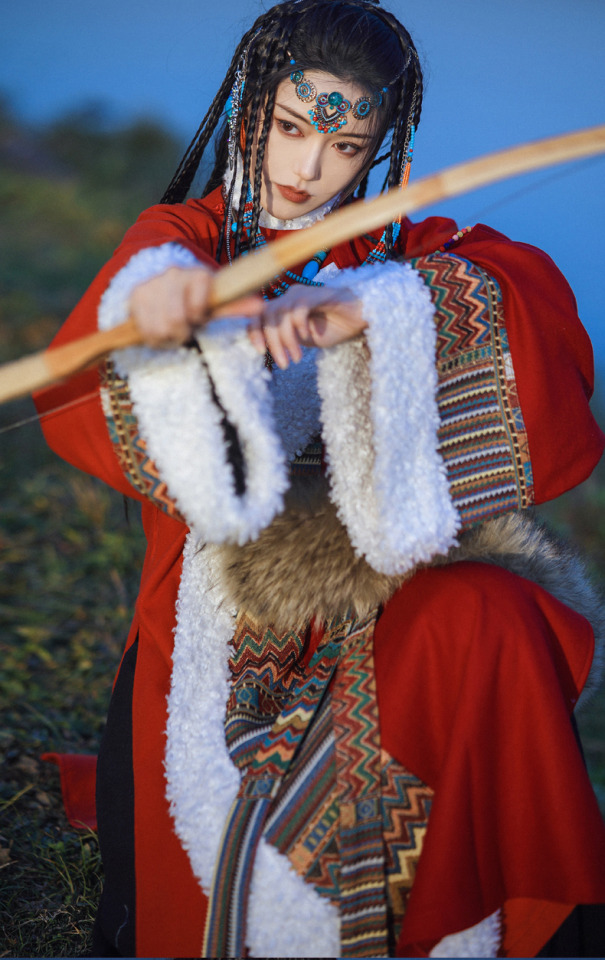
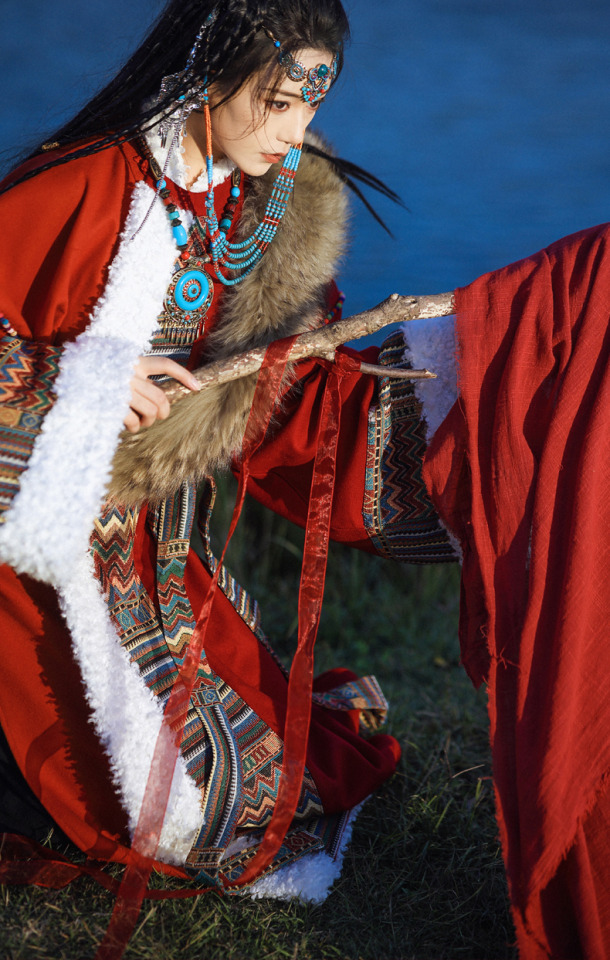

chinese hanfu mixed with tibetan fashion - basic shape: yuanlingpao + pattern of tibetan robe by 宴山亭
#china#hanfu#fashion#chinese fashion#ethnic fashion#tibetan fashion#the collar of tibetan robe is the same as that of cheongsam/qipao#stand-up collar#so this costume cannot be called a tibetan robe#this mixed fashion is a trendy among young people recently
428 notes
·
View notes
Text
gareth edwards 🤝 david cage
total inability to grasp the function of AI as a metaphor in sci fi storytelling as well as an overall lack of sensitivity towards geopolitical allegory within their childlike both-sides wankery that is too poorly removed from real-life aesthetics to be taken at face value
#you could even replace the tasteless civil rights allusions with gross orientalism and essentially turn one into the other. fuck me#I am going to be such a hater on the creator I am so sorry if folks here enjoyed it. no offense and no hard feelings#but if you ever wondered what it would be like if detroid become racist was a movie with a different aesthetic package but the exact same#optics and thematic follow-through. boy is this a perfect flick for you#if you are going to flippantly anthropomorphize your robots to the point of imbuing them with historically loaded cultural aesthetics.#then you're not in need of telling a heightened genre story within scifi trappings. you can just write a fantasy flick or even just#something real or historically rooted. otherwise you lean into the DIFFERENCES and make THAT the root of acceptance#otherwise you're just wanking yourself off for dressing robots in tibetan robes and making it sad when they blow up from american nukes#good lord have some tact or nuance in your god damn filmmaking. I know it's dire in hollywood right now but I KNOW y'all can do better#text#negativity#genuinely a david cage moment but in movies. ladies and gentlemen. we found him
11 notes
·
View notes
Text
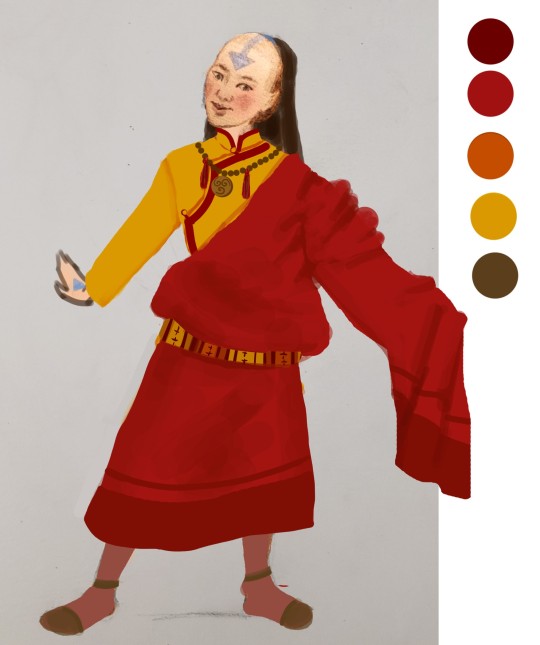
I redesigned Yangchen's outfit!
... I actually designed a lot of outfits for her, because I am Extremely Normal about these books, and also I like costume design and learning about historical clothing.
Short disclaimer: These fantasy clothes aren't culturally or historically accurate, just historically and culturally influenced. I don't have any expertise in East or Central Asian culture or clothing, I've just been clicking around on the internet a lot the last two weeks learning things because that's my idea of fun lol. If you wanted to talk to people who actually know things you should check out @atlaculture or like @ziseviolet, both of whom's blogs I referenced while drawing.
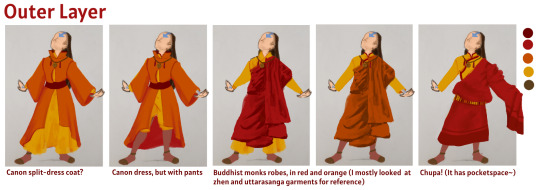
I only designed two alternates for the outer robes. The first is based loosely off the robes Buddhist monks wear (loosely, because drawing draped fabric is hard ^^') especially the Tibetan zhen robe. This garment is just a long wide rectangle of cloth which can be draped across the body in lots of ways (versatility ftw!).
The other garment I drew is a Chuba, a traditional garment from Tibet and the Himalayas. It's a robe, but it highkey reminds me of kilts and hoodies, in that it a) can be worn over one or both shoulders or just as a skirt and b) it makes a giant pocket over the stomach. The long sleeves can be folded up or tied back btw.

I spent the most time on the middle layer, because I was thinking it has to be something she could comfortably fight in while also being suitable for diplomatic meetings, meditating, espionage, and possibly sleeping.
And like. You can fight and hike and whatnot in loose skirts, but it's annoying how twisted up they can get while sleeping. ALSO, YC does a lot of flying and leaping, so my girl needs pants. My faves are definitely the Xiaolin monk pants and the yellow wrap pants Aang wears. I tried dhoti (Indian wrap pants) because that kind of looks like what the giant statue of Yangchen meditating might be wearing, but I think it looks odd paired with a highwaisted shirt instead of a long tunic. Maybe I'll do some more drawings with her in a tunic and dhoti or a monk's dhonka and shemdap later, idk.

As any good historical fashion nerd knows, foundational garments are everything (◡‿◡✿).
But also, there's a scene where Yangchen and Kavik pretend to be lovers, and are "discovered" by a maid sleeping in the same room, with Yangchen in a state of partial undress (gasp!)
I am living for this fake drama; I need to know how scandalized the maid was lmao.
When the maid walks in, Yangchen immediately wraps herself in a bedsheet before ushering the maid back out the door. Maybe all she did was take off her outer robe... but why would she need to wrap herself in a sheet if she was wearing a long-sleeved high-necked gown? I got the sense from both the book and cursory research about buddhist monks that walking around without your outer robes was socially acceptable, at least in casual settings. I think it more likely she was in her underclothes, which historically (in the west anyway) would also double as sleeping clothes.
"The Aang" is censored because this is Tumblr-dot-com. Its mostly a joke, but also, I know other countries are less uptight about bººbies, so like, maybe it's a valid option ¯\_(ツ)_/¯
The ~Water Tribe~ look is based off Sokka's swimwear and not Katara's, mostly because chest binding seems antithetical to airbending.
All the other undergarment designs are based on hanfu neiyi, because that's what I could find reference photos and romanized names for.
I'm tired of typing now. Lemme know if you have questions about something, or want me to post a larger version of a specific outfit. I am open to feedback and tentatively open to requests.
#costume design#character redesign#Yangchen#avatar#airbenders#air nomads#avatar novels#chronicles of the avatar#atla#I realize now there are typos in the jpeg rip#too late to change it now
434 notes
·
View notes
Text
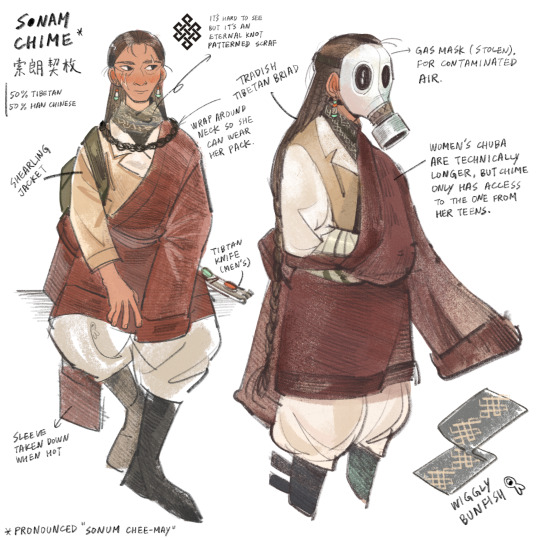
Some outfit exploration for my OC Chime, a Tibetan nomad! She's the best lil guy for me to play around with the concept of lengthy braids that can be wrapped around your neck. Technically a women's chuba (Tibetan robe) goes down to one's feet, but Chime only has access to the one from her childhood, so it's easily mistaken as men's :D (oh, and the gas mask? don't worry about it<3
#COUGH COUGH I HAVE. A FEVER#anyway#I drew this some weeks ago and I have nothing to do now so. I release this into the wild#watched so many documentaries on Tibet and fell through so many online article rabbit holes#it was fun#also if you haven't seen the Nepali movie Karma I highly recommend it#it has nunnery friendship and adorable old women#ily gramma with the fruit basket#posting oc art. embarrassing.#uuh lets see#bunfish ocs#sonam chime#wigglybunfish#nomad goatherd star
248 notes
·
View notes
Text

Expedition Pilgrims
Sha Wujing (435cm): His outfit is mostly inspired by Mongolian clothes since he's found in the Gobi desert stretch of the journey. His bangles are made of fossil bone, and he can use the waist cloth as a headwrap during adverse weather. His markings are inspired by African Lungfish and Mudfish fins, as they are species that exist somewhere between water and dry air. The beasts on his knees are an extension of him, and he can see and speak through them as needed. His beard and long hair can have Ghibli physics depending on his mood and emotions.
Zhu Wuneng (~300cm): Inspired by Northern Tibetan clothes, as that's the region the group recruits him. Traditional clothes tend to have way more accessories and golden details so I had to simplify a bit. His features are a mix of wild boars and Indonesian babirusa, with the iconic bristles on his head. I leaned on ceremonial Tibetan swords and necklace beads for the decorations on his rake. His vest can be closed, he just prefers not to most of the time.
Sun Wukong (125cm): I've already commented on his design over here, but I'll elaborate that the yellow shirt is the one he gained from Tripitaka soon after he was released, while the pants and red half-robe were the garments he was given by Guan Yin. The hoops on his feet and purple beads were reacquired back in Huaguoshan when he first fled the pilgrimage, heading to his family instead of Ao Guang's palace.
(A-ma and Jinju gave them to him so he'll always have something to home to remember them by, as well as where he first started, as the beads were gained during his lessons with Subodhi.)
Tripitaka (163cm): This is but one of his many outfits since travel can be rough on clothes, and even more so when you get kidnapped by demons and thrown off your horse all the time. He wears the usual orange monk robes, with some kind of travel clothes over them. He gains some fur boots from Boquin for cold weather but usually prefers sandals most of the time. He seldom uses the cassock and crown he received from Guan Yin, save for when he pays respects to temples and holy sites, but the staff is a constant companion.
Ao Lie (167cm, 130cm at the shoulder as horse): Being effectively in exile until the journey is complete, he wears less fancy clothes than he usually would as a prince, but his status still shows. I tried to balance more casual hanfu of the era with some armor parts, like the waist guard and armored boots. He was given the skill to shapeshift into a horse by Guan Yin when she commanded him to wait for the chosen pilgrim monk, so he can shift at will, but preferably when the tack has been taken off. Speaking of, tack is lost and replaced multiple times during the journey, so I didn't depict any specific one.
my Expedition AU designs and heights for the five lads, ive spent so much time on this its not even funny lololol but hey it's done!! i'm free!!
#journey to the west#jttw#xiyouji#jttw au#jttw fanart#expedition to the west au#Sun clan au#bell dragon art#sun wukong#monkey king#sha wujing#zhu bajie#tang sanzang#tang xuanzang#tripitaka#bai longma#ao lie
691 notes
·
View notes
Text
Avatar Cycle Trivia
Avatar Wan
Wan's name translates to "ten thousand" in Mandarin Chinese, as he lived ten thousand years before Avatar Korra. His name is also a pun on "one", as in Avatar number one.
Wan wore the colour of each of the four nations during his battle against Vaatu. His robes were yellow and orange (air), his armbands were green (earth), his sash was blue (water), and his scarf was red (fire).
In addition to becoming the first Avatar, Wan is also the first true firebender, as he was the first person to learn firebending from a dragon.
By fusing with Raava during Harmonic Convergence, Wan is technically the oldest Avatar to be identified, being 21 at the time.
The Earth Kingdom battlefield where Wan died is the same field that Zuko visits millennia later in Zuko Alone (Book 2: Episode 7). Interestingly, Wan first appeared in Beginnings, Part 1, which was the seventh episode of Legend of Korra, Book 2: Spirits.
Avatar Yangchen
Yangchen is the only known Avatar to have a sibling (Jetsun).
Yangchen is technically the first Avatar to have an established Team Avatar (not counting Wan and Raava).
Yangchen had split-personality disorder with her past lives, where she essentially suffered from nightmares of her past lives bleeding into her present self.
Yangchen's companion Kavik is the first person ever seen get chi-blocked.
Yangchen did not like the idea of people creating statues of herself in the future. Ironically, she was greatly revered in the Four Nations, and a statue each was built in both the Eastern and Western Air Temples.
Avatar Kuruk
Kuruk is currently the only known Avatar whose predecessor and successor were both women (Yangchen and Kyoshi respectively).
Kuruk had more lovers in 3 decades than Kyoshi did in over 2 centuries (the true story is more tragic).
Kuruk had a habit of challenging random people to feats of strength, which makes him the only known Avatar in history to have participated in an Agni Kai.
Kuruk was the best hunter and tracker in the history of the Four Nations. It's said there was nothing he couldn't hunt or track down (that includes spirits).
Kuruk is the only known Avatar to enter the Spirit World after death. Considering that only people with a special connection to the Spirit World can enter at death (such as Iroh and Yue), this means Kuruk must have had a spiritual connection rivalling that of most Air Nomad monks or nuns.
Avatar Kyoshi
Kyoshi is the only known Avatar known to be of mixed nationality; her father was from the Earth Kingdom, while her mother was a renegade Air Nomad.
Kyoshi had a rare condition with her earthbending where she could move large objects with ease but had difficulty in moving smaller objects (Suffering From Success).
Kyoshi has witnessed more passings of Sozin's Comet than anyone else, with three (not counting Lao Ge).
Kyoshi learned the secret to immortality from Lao Ge, which led her to have the longest lifespan of any Avatar.
Kyoshi has threatened both the Earth King and the Firelord.
Avatar Roku
Roku and Firelord Sozin share the same birthday.
Roku has been featured in the introduction sequences of both Avatar: The Last Airbender and The Legend of Korra.
Roku is the only known Avatar to appear old when he was called upon by the current Avatar.
When Roku entered the Avatar State for the first time, he destroyed the Fire Sage Temple.
Roku's dragon Fang is the only animal companion ever seen in the Spirit World.
Avatar Aang
It took Aang longer than any Avatar in history to become fully realized, being over a century old.
Aang has a scar on his back and on his foot, because of how electricity works.
Aang choosing four toys out of thousands – to identify him as the Avatar as these four toys were the same ones that past Avatars had chosen for generations when they were children – was the same procedure used by the Tibetan Buddhist monks to recognize the next reincarnation of the Tulku Lama.
Aang has met the original source of every bending art: a flying bison for air, the Moon Spirit for water, badgermoles for earth, and two dragons for fire.
Aang is the first Avatar to have his picture taken.
Avatar Korra
At four years old, Korra is the youngest Avatar in history to be identified.
Korra is the first Avatar to learn spiritbending.
Korra is the only Avatar to break out of bloodbending without the use of the Avatar State (sorry, Aang).
Korra is the only Avatar to have killed a member of her own family (Unalaq).
Korra is the first known person to ever tame a polar bear-dog (Naga).
Miscellaneous
Wan and Roku are the only two Avatars to die in combat.
Roku and Aang are the only two Avatars to fight a volcano. Aang was successful, while Roku died.
Aang and Korra are the only two Avatars to ever be defeated in the Avatar State.
Aang and Kyoshi are the only two Avatars to ever get hit by lightning. Ironically, when Kyoshi was hit by lightning, her chakras were opened and she gained the ability to enter the Avatar State; conversely, Aang's chakras were blocked and he was unable to enter the Avatar State.
Kuruk and Roku are the only two Avatars to have been identified the "traditional" way in their respective nations at 16; Wan fused with Raava at 21, Kyoshi was identified at 16 when she recited Kuruk's poem, and Yangchen, Aang and Korra were identified at younger ages.
Yangchen, Aang, and Korra are the only Avatars to have been identified at younger ages than 16.
Wan, Aang, and Korra are the only Avatars who are modeled after real-life people. Wan is modeled after co-creator Bryan Konietzko (but with cooler hair); young Aang is modeled after Arjuna, Sifu Kisu's son (but Aang is bald), while adult Aang is modeled after co-creator Mike DiMartino; and Korra is modeled after various female MMA fighters, most notably Gina Carrano.
Roku and Korra are the only two Avatars who have worn an outfit from each of the four nations on-screen.
Roku and Korra are the only two Avatars to have connections to royalty. Firelord Zuko, and thus every following Firelord, are descendants of both Roku and Sozin, whereas Korra's father was a member of the Northern Water Tribe's royal family, and was later elected as the chief of the newly independent Southern Water Tribe.
When Kyoshi first met Yangchen, she (Kyoshi) mistook Yangchen for her own mother.
When Kyoshi first met Kuruk, she almost drowned her physical body trying to communicate with him.
Roku and Yangchen are the only two Avatars to have hugged the current Avatar at the time (Aang and Kyoshi respectively).
Wan, Korra, and Kuruk are the only Avatars to refer to Raava by name, although the latter (Kuruk) had never met Raava.
Yangchen, Kuruk, and Aang are the only Avatars to have invented an airbending technique. By extension, Kuruk is the only person outside of the Air Nomads to invent an airbending technique (he didn't get his mastery tattoos, what a shame).
Aang and Korra are the only two Avatars to learn energybending.
Kyoshi, Roku, and Aang are the only Avatars to use bending after their respective deaths.
Kyoshi, Roku, and Aang are also the only Avatars to have descendants (but let's be realistic, so did Kuruk).
Aang and Korra both learned their native element from a companion of the previous Avatar, and their final element from a descendant of the previous Avatar. Aang learned airbending from Monk Gyatso, a companion of Roku, and learned firebending from Zuko, Roku's great-grandson. Korra learned waterbending from Katara, Aang's wife, and learned airbending from Tenzin, Aang and Katara's youngest son.
That's all the fun facts I could find.
240 notes
·
View notes
Text
So guess who forgot to post my first kyoshi fanart when I made it- let me check 6 months ago. Figured I should since I've only been reblogging for a hot minute

There's also another kyoshi sketch that I kinda decided not to put as much effort into, and a Yangchen and Kavik WIP

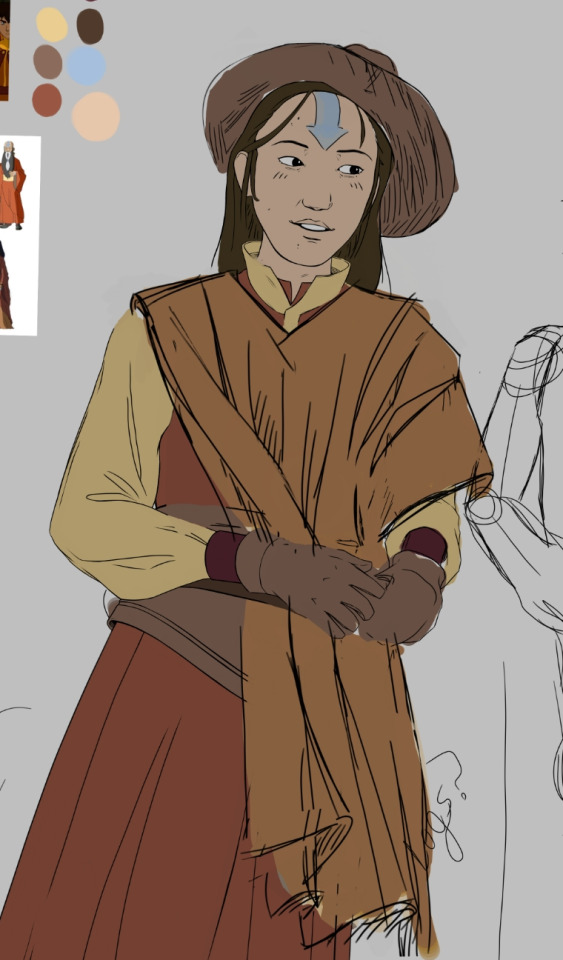
Now I'm not done with yangchen, not even close, I started that piece a long time ago and it's the result of a poncho rabbit hole. The hole theme has just cowboy au and her poncho is supposed to resemble more llanero esque fits
I chose llaneros because I thought theirs resemble the robes in atla a little more. I wanted to also incorporate a bit of design influenced by Tibetan yak herders but I could hardly find anough reliable info.
Anyways kavik is there too but I'm still planning for him. I plan to decorate their fits a lot more cause I did way too much research to not go all out.
#atla#kyoshi novels#kyoshi#yangchen novels#yangchen#kavik#xu ping an#I think that even these novels had its flaws#some stuff just feels off#but im also interested in any scrap of lore#llaneros
274 notes
·
View notes
Text
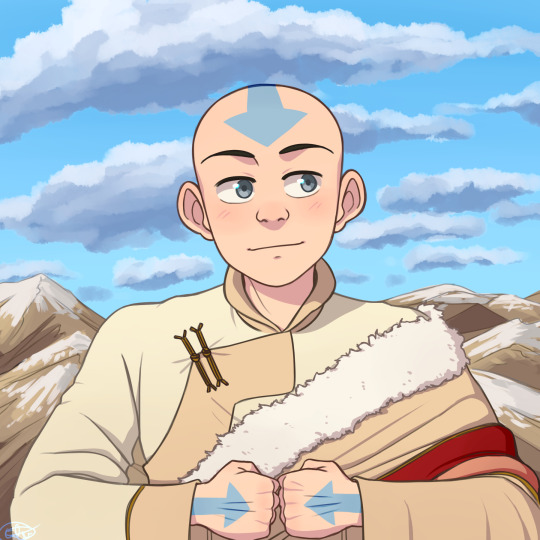
I'm basically obsessed with researching clothing for different regions for OC ideas, and knowing that the Air Nomads were based on Tibetan monks, I think there was a real missed opportunity to show Aang wearing a chuba in the show!
It's an ankle-length robe tied around the waist with a sash, usually made of wool or sheepskin, that originated in Tibet. I'm sure the Northern and Southern Air Temples get quite cold, so it doesn't seem too out there for the monks at those temples to make wool winter garments like this.
#avatar#atla#avatarthelastairbender#avatar the last airbender#aang#avatar aang#legend of aang#art#artists on tumblr#circe draws
1K notes
·
View notes
Text
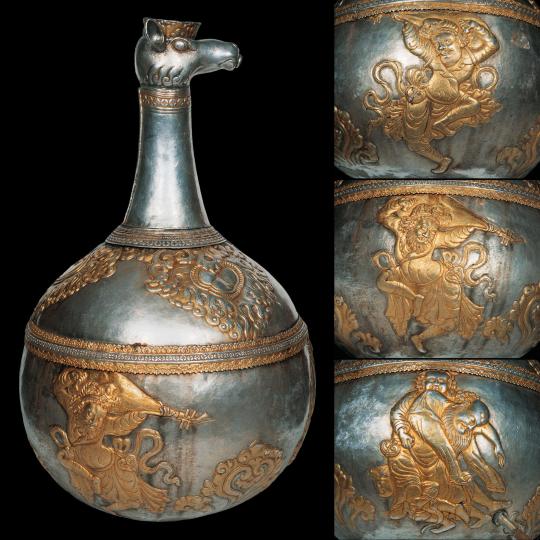

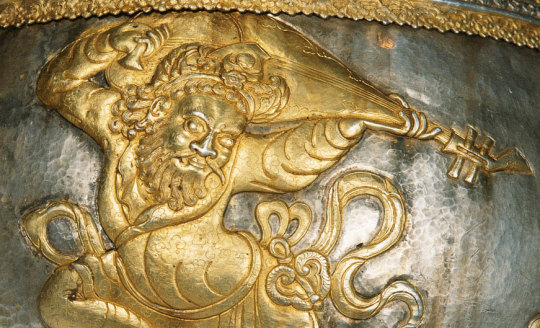



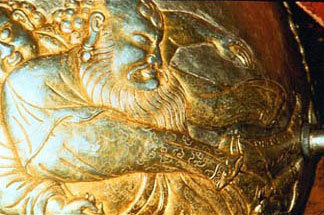

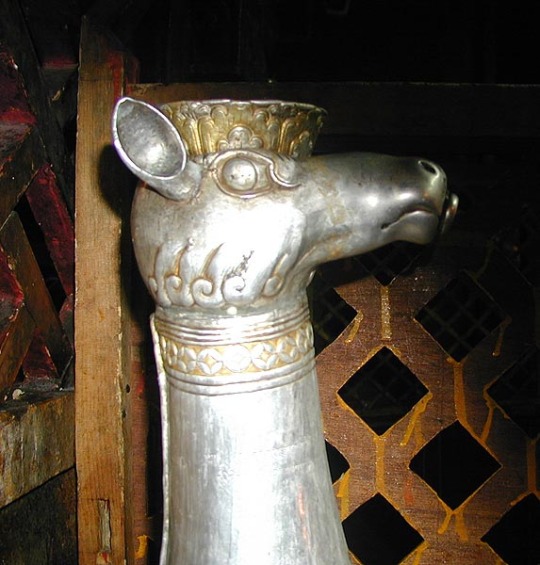
The Jug of Jokhang 7th-8th C. CE. Central Asians (probably Sogdians) depicted on Tibetan art.
"At present, a silver jug stands in a wooden frame in one of the chapels of the Lhasa Jokhang, traditionally regarded as the oldest temple in Tibet (see figs 1-7). This jug is approximately 80 cm in height. It was hammered from silver sheets, cut and assembled in four parts, two hemi- spherical sections joined at the diameter of the circle, a long thin neck, surmounted by an animal head with round mouth from which liquid can be poured. It weighs some 35 kg when full of liquid, and monks fill it daily with offerings of chang, Tibetan barley beer. The gilded designs on the upper bowl of the jug are raised scrolling in heart shaped medallions, while on the lower bowl, there are three scenes representing Central Asian people, two lively solo dancers and three men in drunken revelry". (taken from AsianArt by Amy Heller).
Dance was a skill that Sogdians learned at a young age, and continued to use as they got older:
"The Iranian from Tashkent [Chach] appears young
He dances to the music before the wine goblet, as rapid as a bird
He wears a cloth cap of foreign make, empty and pointed at the top
His Iranian robe of fine felt his tight sleeves"
(Shafer 1963, 55 in Lerner 2001, 254)
#tibetan art#sogdiana#ancient history#history#art#art history#art detail#buddhism#temple#beer#iranian#dance history
345 notes
·
View notes
Text

Lunar Dharma Dates for 2024: Buddha Days, Recurring Puja Days, Annual Celebrations in Three Buddhist Traditions
Tibetan Buddhist Deity Medicine Buddha, Brocadeless Thangka
The Medicine Buddha, also called Bhaisajyaguru, is called as such because he is revered for his power to heal physically and spiritually. He is said to heal dukkha or suffering. He is wearing a monk’s robe and is pictured in a cross-legged seating position (Dhyana Aasan). True to tradition, this thangka depicts his left hand in a meditation position on top of his lap while holding a bowl filled with the nectar of life. His other hand appears to be in a wish-granting mudra or position while holding a stem of the myrobalan plant (said to carry medicinal benefits). His most distinguishing feature is his blue skin as he is associated with the precious stone lapis lazuli which comes in rich blue color. Even his Pure Lands is said to be abundant with this stone and in this color, too. This thangka uses rich red color for the rest of the piece (signaling wealth or health) with gold used as outline and color for the other elements. Gold is associated with the sun and the enlightenment it represents. Animals also appear in his aura such as the dragon, tiger, a garuda, and lion to represent the four quadrants of the heavens and the cardinal directions. A snake on the thangka also symbolizes the cycle of life, birth, living, death, and rebirth as related to the snake shedding its skin in its cycle. At the bottom of the thangka is an altar of offering to the Buddha.
33 notes
·
View notes
Text
alright, i'm done dealing with this bullshit.

i didn’t want to address this any further but since these people seem utterly obsessed with me & and have now gone on to harass my friends, i have had enough.
first things first, and i can't believe i even need to say this, but aang is a fictional character. he is not tibetan, because there is no tibet in the world of avatar: the last airbender. aang - and the air nomads in general - are the products of two white men's (and a predominantly white writing team's) interpretations of buddhism, hinduism and tibetan culture, interpretations that have themselves been criticized by actual tibetan people.
criticizing, mocking, or even making fun of aang does not make me racist towards tibetan people, just like criticizing zuko wouldn't make me racist towards japanese people, or criticizing toph wouldn't make me racist towards chinese people, because none of these characters are actual depictions of real life groups or cultures. they can't be, because those groups and cultures do not exist in the world of atla. (xiran jay zhao discusses this very topic, and the show's "representation" of asian and indigenous cultures, better than i can in their video essays, if anyone is interested in hearing more about atla from an east asian perspective.)
additionally, even if aang were somehow an actual tibetan monk, i cannot recall a single instance in which i said anything derogatory regarding his cultural practices or beliefs (which, again, stem from bryan konietzko and mike dimartino's understanding of tibetan monks). when i criticize aang (and once again i can't believe i need to say this), i am criticizing the writing of his character and the worldbuilding of his culture and people. not, you know, an actual person and their actual heritage.
i have no problem with aang being a pacifist, or a vegetarian, or shaving his head, or wearing robes. what i do have a problem with is his entire dilemma about killing being brought up in the last four episodes of the show, only to be resolved by a magic rock and a lion turtle instead of character growth and agency. what i do have a problem with is his treatment of katara, and his disrespect towards her cultural beliefs in favour of pushing his own on her. aang is entitled to believe in non-violence and the sanctity of all life; he is not entitled to make that choice for katara, as he tried to in the southern raiders. each of them has a right to their own beliefs, and neither should use their individual beliefs to impose upon the other, or dictate what they should do.
the really ironic thing about all of this is that i love aang. i have said over and over that i believe kat.aang could have worked, that i thought they were cute in book 1, that aang is a great protagonist who had potential for an amazing arc, if only it had been followed through on in book 3. my criticisms of aang's character come from my love for him, because he deserved better than the writers who turned him into their own self-insert fantasy.
so whoever you are that's been endlessly hounding my inbox, and now my close friends', calling me racist because of my opinions on a fictional character: for your own sake, just block me and go on with your life. your social justice crusade against a singular stranger on the internet isn't helping anyone, let alone actual tibetan people.
#the discourse#i really didn't want to bring this up again but given that this has now spread beyond just my inbox i felt i had to address it one last tim#i hope this clears it up for anyone who might have seen what's going on and is confused#further anons will just be blocked and deleted so you really might as well save your breath#anti kataang#aang critical#atla critical#anti bryke
135 notes
·
View notes
Text
Nayshall's clothing (pt. 1)
I'm gonna be 100% honest with ya'll. I was writing a Bosch smut and for the life of me, I didn't know the names of the clothes he was wearing. But I didn't want to put "Robes" and move on, so I did a deep dive into Nayshall's clothes.
Nayshall is a blend of multiple cultures in one, but the general consensus of forums on Reddit and other forums was that Nayshall was inspired by Bhutan, Nepal, Indian, and Tibet cultures.
This is going to be split into multiple of parts because Nayshall has a lot of different types of clothes so I won't be able to cover it in one sitting. I barely even scratched the surface here.
If anyone is more knowledgeable than me and sees that I got something wrong please tell me in the comments. But I'm posting this because I want people to see the hard work the street-fighting devs put into this and the world of Nayshall.
Chuba


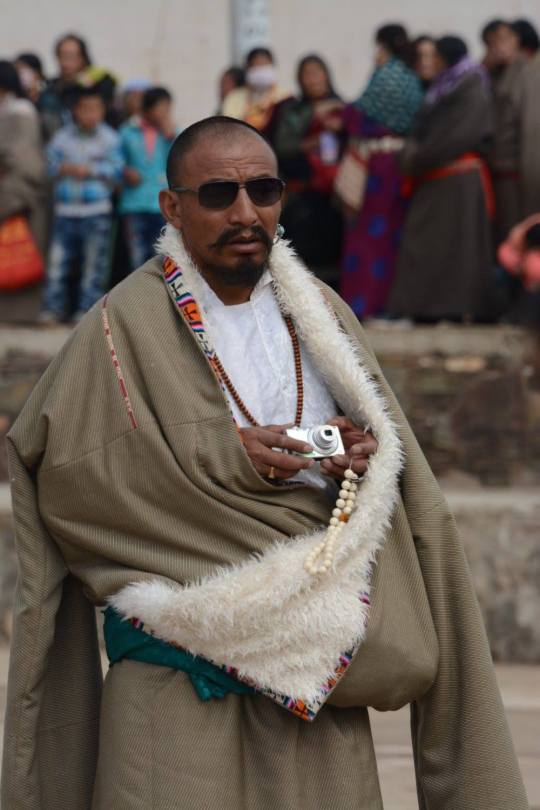
The chuba is a floor-length, left-crossing loose garment that is adjusted at the waist with a wide, usually red cloth belt, and pulled up to different degrees according to sex, rank or region. It is an extraordinarily adaptable garment worn by town dwellers, farmers, nomads, men and women alike, and is equally wearable on horse or motorcycle.
Chubas are pocket-less and held together with a waistband, with room in the front that serves as an “inside pocket” or inner pouch to store necessities such as food items, money belts, amulets, personal things, and even an infant in the bosom.
The chuba can be worn in different lengths, and the shorter the chuba, the more voluminous the pouch resulting from the overhanging material used to hold small items. Women wear their chuba ankle length, while men mostly pull them up the mid-calf or above the knee. Tibetan weather is fickle and temperatures can rise and fall within minutes.
Half-chupas: Just the skirt
Full chupas: Can be worn with a shirt
One-piece chupas: A one-piece dress
Town women: Wear their chubas floor length with pumps or high heel boots
Farmers and nomads: Double them over trousers
Ex: Rewancha, Yua, and Bosch all wore a form of chuba as their gown. The Chuba had 2 sleeves, but the locals usually only wear one sleeve and leave the other hanging loose. This is a way of adjusting the body temperature. When it gets hot, they take off one sleeve to cool down a bit. But if the temperature keeps rising they remove another sleeve too. We can actually see in Bosch's picture that the other sleeve is tucked in the back.
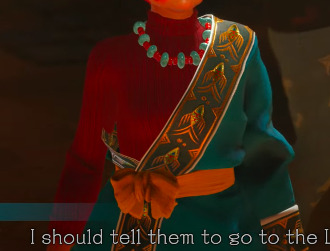


They often have soft fur, pulu, or colorful cloth on the collar, front, cuff, and lower hem of the gown.
5 types of robes could be made out of, Pulu woven fabrics, lambskin robes, sheepskin robes, woolen robes, and light robes.
Woolen robes are made with inner layers of sheep fur, so they are light and warm, making them popular in warmer, agricultural areas like Nayshall.
Pulu, the traditional Tibetan wool fabric, is made by fluffing and combing the wool into a thread by fingers, then weaving it with a wooden shuttle loom. Pulu robes are a favorite in pastoral areas as well as farmland.
Lambskin is ranked by degree, according to the length of lamb hair, curliness, and quality of the skin. 40+ lambskin is necessary to make a medium-class lambskin robe.
Shirts


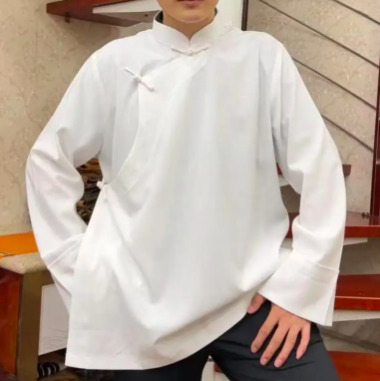
pants

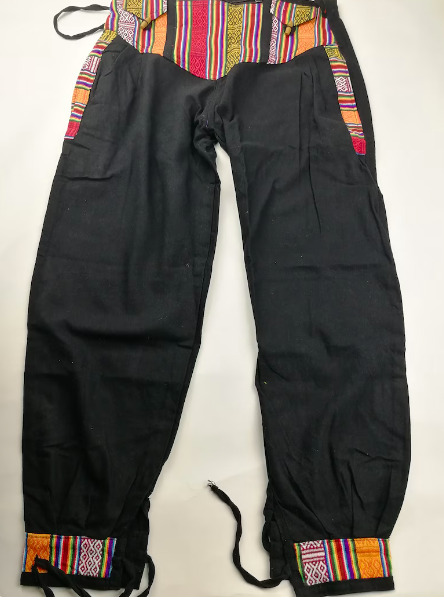

Modern and traditional
A growing trend among young Tibetans is blending traditional and modern casual clothing. Young Tibetans often try to find a balance between modern styles and their cultural heritage. It is not uncommon to see some Western-style clothing like jeans and t-shirts
The classic chuba robe is still everywhere, but Tibetan youth will make stylish adaptations. The cut of the fabric or the embroidered designs will be changed to something more contemporary. These changes show the desire to keep old traditions alive while making innovations to express personal style.
Ex. Same with the people in Nayshall they blend traditional and modern together. Shopkeeper Tsanpa wears jeans with his gho (Bhutan) tucked in. Yua wears modern shoes that resemble Tibetan boots, and Kina wears a beanie on top of her head.



note that Kina may also be wearing a Kora Yushu hat.
The Kora Yushu hat is made from a blend of yak and merino wool, and its fabric originates from Tibet and China. Kora sources the wool directly from Tibetan communities to ensure its quality and origin. The hat is lightweight, warm, and thin enough to fit beneath a hood or helmet, making it suitable for winter and mountain use.

Hairbeads
Tibetan hair jewelry, including braids and hair beads, is used to mark life milestones like birth, marriage, adulthood, and death. The jewelry often reflects the colors of nature.
Tibetan hair beads can be used by both men and women. In Tibet, long hair was recommended for both men and women, except for monks and nuns. Tibetan braids can signal a woman's marital status, social rank, and tribal affiliation. Tibetan men wear hair beads but there is no male equivalent.

Headdress
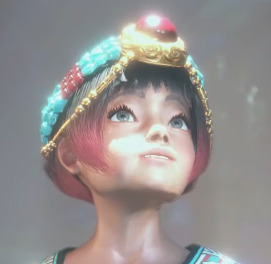

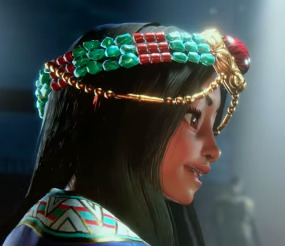
Tibetan headdresses vary by region, age, and marital status. For example, unmarried girls wear a single braid with a red hair string, called Xia Jiu in Tibetan.
Tibetan women wear headdresses on special occasions, such as festivals and their comings-of-age. Headdresses can be colorful and made of coral, turquoise, or other materials. For example, a "Bazhu" is a deluxe headdress made of coral or turquoise with gold or silver earrings. Tibetan women also wear silver bracelets on their left hand and white conch bracelets on their right.


Jewelry


Tibetans traditionally wear jewelry, which is often made from gold, silver, and precious stones. The most common gems used are turquoise, coral, and pearls, which are used in necklaces, earrings, hair ornaments, and to decorate ritual objects. Tibetan jewelry can also be made from cow bone, amber, shell, and agate.
Tibetans wear a variety of jewelry, including ornaments made of gold and silver, as well as jewelry made of amber, agate, jadeite, pearl, and ivory. Tibetan jewelry traditionally features materials from across South Asia, East Asia, and the Middle East, and the symbols on Tibetan jewelry are usually from Himalayan Buddhism. Tibetans like to wear many ornaments and jewelry, such as Buddha beads, hair bands, hair accessories, belts, prayer beads, and necklaces.
Jewelry is a symbol of status and wealth in Tibetan culture, and each design has a specific meaning. For example, ornaments with symbols of animals, flowers, and stones are often given to commemorate special occasions. Some also believe that wearing gold enhances spiritual power over evil spirits. Offering jewelry to holy statues is thought to generate positive virtue for the donor.
This article also goes into the types of ornaments they use in their jewelry
Jewelry can also serve as a talisman, with different amulets protecting against disease and harm. For example, coral and turquoise are said to ward off evil spirits and illness.
Many Tibetan jewelry pieces are passed down from generation to generation. For example, some Tibetan-style pendants are used in Buddhism as ritual instruments to subdue demons, which are believed to dispel sins and bring people power, intelligence, and courage. Many of these pendants also have Sanskrit inscriptions of a religious symbolic nature.
Braids
Braids are also a symbol of strength, wisdom, and identity for some indigenous men and boys. They can also represent a connection to the earth, ancestors, and the creator. For example, in Native American tradition, hair is a signifier of spiritual practice, and braiding demonstrates strength in unity
boots
sumba shoes

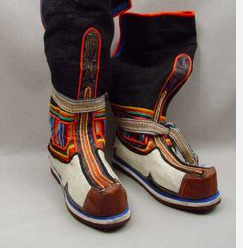

Tibetans typically wear boots, which are more cultural representations than practical clothing. However, due to the prevalence of mass-produced shoes, traditional Tibetan boots are no longer the daily footwear for ordinary Tibetans. Instead, they are now usually part of ceremonial attire.
Tibetan boots are a significant part of the Tibetan way of life. They are more cultural than practical, and are worn to represent different regions and environments. For example, boots with a pointed toe are suitable for different types of terrain, and can be worn with a garter in cold weather. Boots from different regions of Tibet have different styles and qualities. For example, boots from Chamdo and northern Tibet are simple, while boots from Shannan and Xigaze are more delicate.
Tibetan boots are commonly made from cowhide, pigskin, corduroy, and pulu, a traditional woolen fabric. Other materials used include cloth, canvas, velvet, leather, and felt. The original boots were made from yak hide, and the soles were embroidered with patterns like dragons and snakes, and the shoes were decorated with red and green woolen cloth.
Tibetan boots come in two general types: short leg and long leg. Most Tibetan boots are lined or padded, though some may be unlined. The heads of corduroy boots are made of cowhide, and many kinds of pulu boots have cowhide soles.

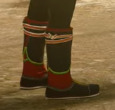
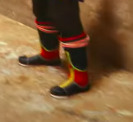
14 notes
·
View notes
Text
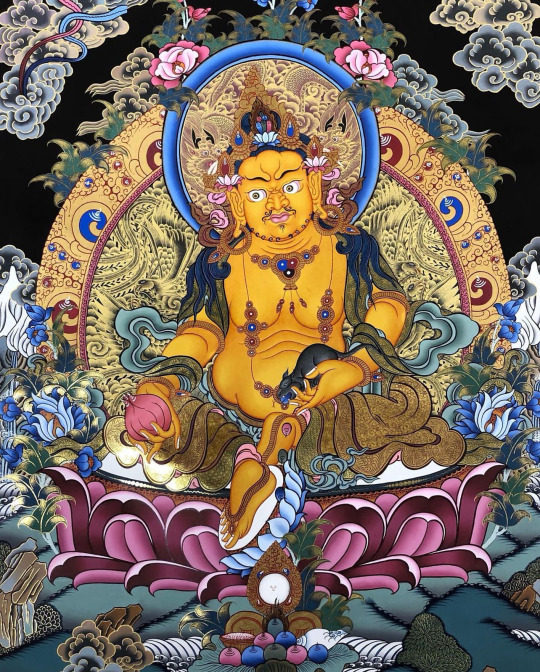
Zambhala in Tibetan Buddhism is commonly regarded as the deity of Wealth. He is the fortune of wealth and prosperity. He is also believed to be emanation of Buddha Ratnasambhava.
Deity of Wealth body colored of gold, beautiful in silk robe and jewel ornaments. His right hand holds a fruit and a left hand holds mongoose of jewel treasure. He's shown with two feet pressing down on a conch and lotus treasure.
He has ability to remove poverty within six realms, increasing faith, lifespan and wisdom. What one should learn from Zambhala is his broad and generously giving heart. Therefore, one most first learn to actually practice giving. "Giving is the cause of good fortune. One most first understand the principle of "Giving". "Giving," means that one gives everything one has to sentient beings. The three types of giving are: Giving of Wealth, Giving Dharma and Fearless giving.
18 notes
·
View notes
Text
I'm going insane over this information but.
Part of the Monlam festival (Great Prayer Festival) is literally dedicated to Tibet just cosplaying as Mongolia (Yarsol)
"Yarsol is part of Monlam (The Great Prayer Festival), which falls during the first month of the Tibetan Buddhist calendar and was, in the past, held just outside of Lhasa at the Jokang Temple. Throughout the second half of the 20th century, Monlam was periodically banned and reinstated by the occupying Chinese forces, before being suspended in 1990. The festival is still upheld by Tibetan Buddhist monasteries in exile.
Customarily, two prominent men were asked to impersonate Mongolian generals and act as hosts for the festival - a great honour and a great expense. Here, one wears the winter garb of a gentleman of the Khalkha Mongols, with brocade robes and a black fox-fur hat. His silk shirt had to have five colours showing.

In hot weather a fabric cloak and a papier maché hat would be worn.
During the last days of Monlam, archery, shooting and wrestling displays are held; this part of the festival is called Yarsol.
Participants wear historical costumes, like this performer who is depicted wearing a seventeenth century Mongolian-style uniform.
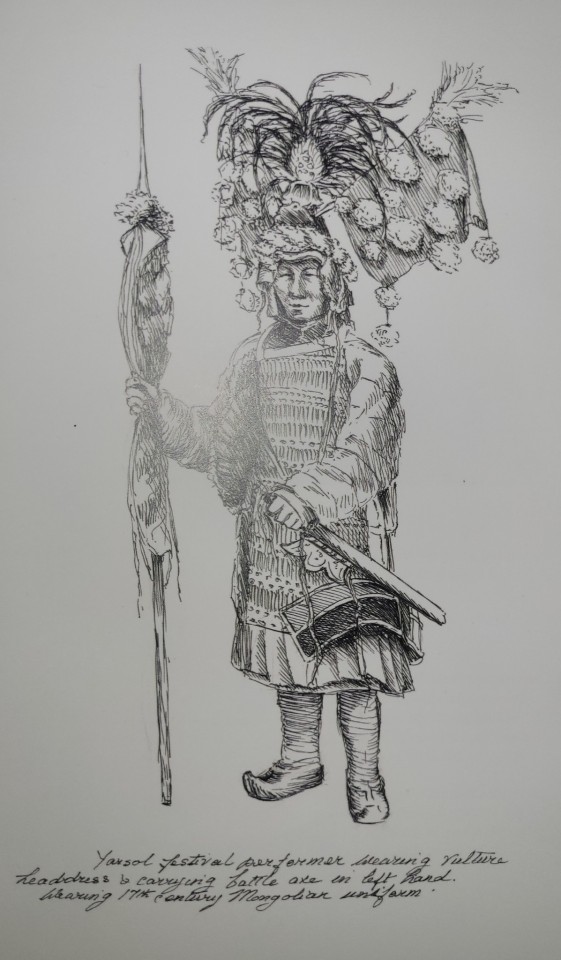
He wears a vulture headdress and carries a battle-axe in his left hand."
They're insane for each other your Honour.
Source is the book "The Fabric of Tibet", illustrations by Anne Jennings
#hetalia#aph mongolia#hws mongolia#hetalia world stars#hetalia world series#hetalia world twinkle#Hetalia Mongolia#Aph Tibet#Hws Tibet#Hetalia Tibet#Tibmon#Tibmongol#Tibet x Mongolia#Mongolia x Tibet#Historical hetalia
17 notes
·
View notes
Text

ATLA Gender Bender: "Aangi"
Aang -> Aangi
I have wondered where the name "Aang" originates from. It might actually be derived from the real name "Aangi". In any case, "Aangi" seems like the obvious choice for female Aang's name.
"Aangi" would have probably grown up at the Eastern Air Temple. She may have been frozen in ice while attempting to flee southward from the Eastern Air Temple.
I've been picturing Kiernan Shipka as the voice of "Aangi". Granted, I think Book 1 "Aangi" would sound more like Ikki, but by Book 3 she would sound like 12 year old Jinora.
OUTFITS:
1: Book 1 & 2 outfit
This outfit is designed to match the appearance of young Air nuns, shown in "The Rift".
For her hairstyle, I referred to several images, especially Erik Törner's "Tibetan girl in Shegar, Tibet" (see: www.flickr.com/photos/eriktorn…). I intended for Aangi's appearance to be symmetrical, and for her hair to be relatively short in Book 1, so that her hair could grow longer during the timeskip between Books 2 and 3. Unlike Ikki and Jinora, I wanted her hair to be tied in pigtails instead of buns. This allows her hair to be more expressive, and to flow freely in the wind. Her pigtails are meant to somewhat resemble the wings of a bird in flight. I also decided to have her pigtails tied underneath her ears. This is because Aang sometimes wears hats and other garments to hide his arrow. By tying her pigtails under her ears, this allows her hairstyle to be visible even when she has to hide her tattoo under a hat.
2: Book 1 & 2 undergarments
In real life, Buddhist nuns wear the same triple robe as the monks but with two additional layers, making it a "five-fold" robe (see: hayleyssilkroad.wordpress.com/…) These two additional layers are the sankakshika (undergarment, see: ia800908.us.archive.org/35/ite…) and udakasatika (bath robe, see: www.buddhanet.net/e-learning/h…).
The sankakshika "Aangi" wears in Books 1 and 2 is based on the sankakshika shown here: https://discourse.suttacentral.net/t/what-are-the-original-clothes-of-buddhist-nuns-sankacchika-video/23728/9. It extends from the chest to the navel, and is fastened by three brown, circular buttons found underneath the left armpit. Note that this is an undergarment, not a bath robe. She would not wear this while bathing or swimming, but would be seen wearing this during the Guru episode.
This undergarment would be destroyed by "Azulon"'s lightning in the Book 2 finale, forcing "Aangi" to replace it with an undergarment crafted from red Fire Nation cloth.
3: Aangi's Fire Nation disguise
4: Aangi's Fire Nation disguise, without headband
The three stray hairs on her forehead are a feature she shares with "Princess Zuka".
5: Book 3 outfit, with outer robes
Aang's Book 3 appearance is based on the Shaolin monks. As such, his female counterpart's appearance is based on the "Kung Fu Nuns of Nepal". In addition to their website and Facebook page, I referred to this image specifically: https://www.nbcnews.com/id/wbna49859526
"Aangi"'s robes feature the color red for two reasons. First, as an homage to the maroon robes worn by the "Kung Fu Nuns". It also makes sense as an in-universe explanation, as "Aangi" would have fashioned her new clothes during her stay in the Fire Nation, where most cloth is red.
By the end of Season 3, I think her hair would be much longer, and she would resemble a younger Yangchen.
6: Book 3 outfit, without outer robes
During the progress of the final fight with Ozai, "Aangi"s robes would burn away bit by bit, much like Aang's clothes. This costume would be visible in the middle of her fight with Firelord Ozai.
7: Book 3 outfit, Avatar State as seen in the finale
This undergarment replaces "Aangi"'s sankakshika. It provides similar coverage to Toph's bathing suit, and is somewhat similar to Katara's sarashi. This is how "Aangi" would appear by the end of her fight with Firelord Ozai.
8: Comics Aangi
This is a very similar costume to her Book 3 outfit.
Like what I’m doing? Consider leaving me a donation via Ko-Fi.
#aang#atla#atla genderbender#genderbend#genderswap#rule 63#my art#avatar the last airbender#my headcanons
12 notes
·
View notes